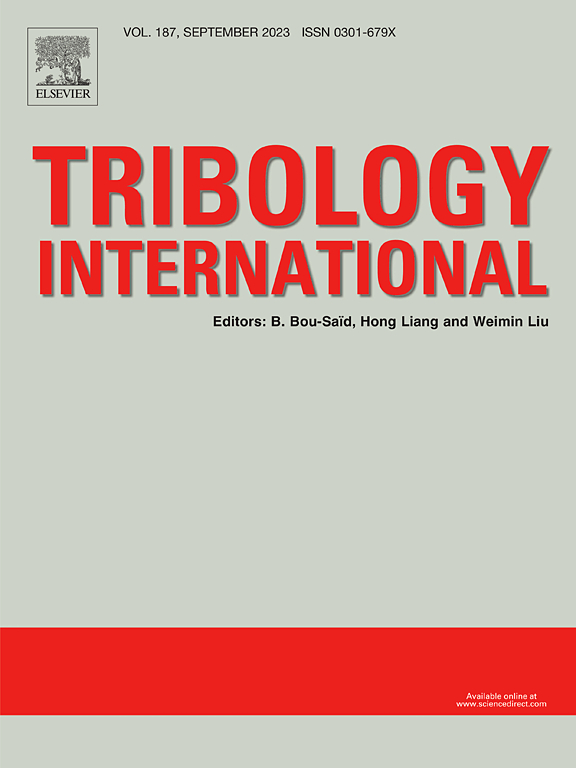Fe-25Cr-20Ni奥氏体不锈钢微刮伤过程中切屑形成和塑性变形的各向异性依赖性
IF 6.1
1区 工程技术
Q1 ENGINEERING, MECHANICAL
引用次数: 0
摘要
金属材料在摩擦学过程中接触面的塑性变形对摩擦副的磨损特性和材料去除机理有重要影响。切屑的形成被认为是导致磨损过程中材料损失的主要机制之一。然而,控制芯片形成的潜在机制仍未完全阐明。采用显微划伤试验研究了奥氏体不锈钢中{001}、{101}和{111}晶粒在不同划伤方向和外加载荷下的磨损行为。系统地研究了从最初的压痕接触到犁削和随后的切屑形成的转变,揭示了晶体取向和划痕方向对切屑形成机制的影响。研究结果表明,切屑的形成和塑性变形与晶体取向和划痕方向有很大的关系,这与颗粒内特定滑移系统的激活密切相关。磨损轨迹内部的深度分布及其周围的表面形貌对摩擦响应和切屑形成过程有重要影响。在特定的载荷条件下,确定了切屑形成的临界深度,低于该深度更有可能发生切屑形成。本研究为研究面心立方金属材料的微尺度摩擦学行为提供了有价值的见解,为优化材料性能、提高耐磨性和延长工程应用中的使用寿命提供了理论基础。本文章由计算机程序翻译,如有差异,请以英文原文为准。
Anisotropy dependence of chip formation and plastic deformation in Fe-25Cr-20Ni austenitic stainless steel during micro-scratching
The wear characteristics of the tribological pair and the mechanisms of material removal are significantly influenced by the plastic deformation of the contact surface during the tribological process of metallic materials. Chip formation is recognized as one of the primary mechanisms contributing to material loss during the wear process. However, the underlying mechanisms governing chip formation remain incompletely elucidated. This paper employs micro-scratch testing to investigate the wear behavior of the {001}, {101}, and {111} grains in austenitic stainless steel under varying scratch directions and applied loads. The transition from initial indentation contact to plowing and subsequent chip formation is systematically examined, revealing the influence of crystallographic orientation and scratch direction on chip formation mechanisms. Our results demonstrate that the chip formation and plastic deformation exhibit substantial dependence on crystallographic orientation and scratch direction, which are closely associated with the activation of specific slip systems within the grains. The depth profile within the worn track and the surface topography surrounding it have a major impact on the frictional response and chip formation process. A critical depth for chip formation is identified under specific loading conditions, below which chip formation is more likely to occur. This research provides valuable insights into the micro-scale tribological behavior of face-centered cubic metallic materials, offering a theoretical foundation for optimizing material properties, enhancing wear resistance, and prolonging service life in engineering applications.
求助全文
通过发布文献求助,成功后即可免费获取论文全文。
去求助
来源期刊

Tribology International
工程技术-工程:机械
CiteScore
10.10
自引率
16.10%
发文量
627
审稿时长
35 days
期刊介绍:
Tribology is the science of rubbing surfaces and contributes to every facet of our everyday life, from live cell friction to engine lubrication and seismology. As such tribology is truly multidisciplinary and this extraordinary breadth of scientific interest is reflected in the scope of Tribology International.
Tribology International seeks to publish original research papers of the highest scientific quality to provide an archival resource for scientists from all backgrounds. Written contributions are invited reporting experimental and modelling studies both in established areas of tribology and emerging fields. Scientific topics include the physics or chemistry of tribo-surfaces, bio-tribology, surface engineering and materials, contact mechanics, nano-tribology, lubricants and hydrodynamic lubrication.
 求助内容:
求助内容: 应助结果提醒方式:
应助结果提醒方式:


